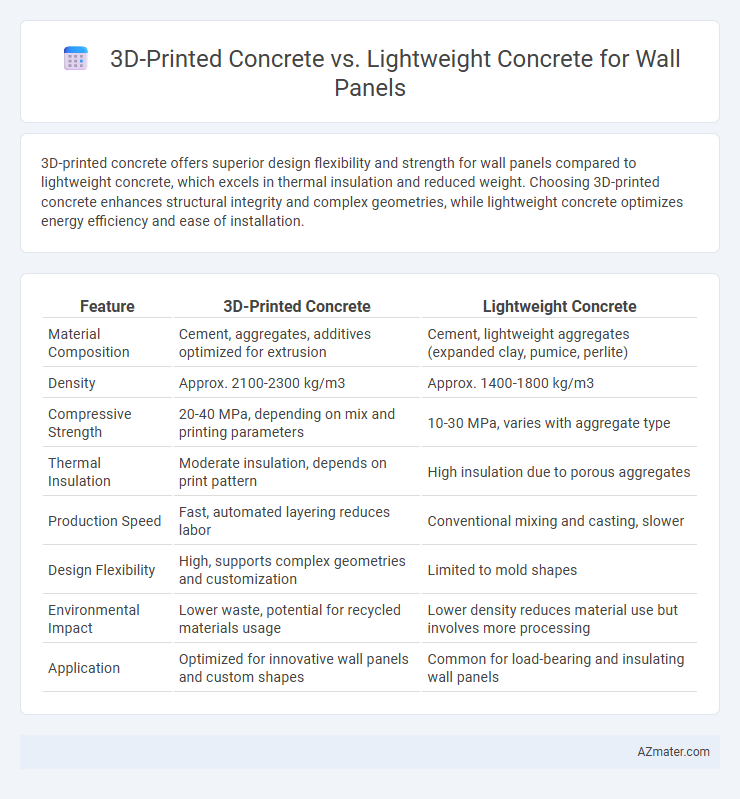3D-printed concrete offers superior design flexibility and strength for wall panels compared to lightweight concrete, which excels in thermal insulation and reduced weight. Choosing 3D-printed concrete enhances structural integrity and complex geometries, while lightweight concrete optimizes energy efficiency and ease of installation.
Table of Comparison
| Feature | 3D-Printed Concrete | Lightweight Concrete |
|---|---|---|
| Material Composition | Cement, aggregates, additives optimized for extrusion | Cement, lightweight aggregates (expanded clay, pumice, perlite) |
| Density | Approx. 2100-2300 kg/m3 | Approx. 1400-1800 kg/m3 |
| Compressive Strength | 20-40 MPa, depending on mix and printing parameters | 10-30 MPa, varies with aggregate type |
| Thermal Insulation | Moderate insulation, depends on print pattern | High insulation due to porous aggregates |
| Production Speed | Fast, automated layering reduces labor | Conventional mixing and casting, slower |
| Design Flexibility | High, supports complex geometries and customization | Limited to mold shapes |
| Environmental Impact | Lower waste, potential for recycled materials usage | Lower density reduces material use but involves more processing |
| Application | Optimized for innovative wall panels and custom shapes | Common for load-bearing and insulating wall panels |
Introduction to 3D-Printed Concrete and Lightweight Concrete Wall Panels
3D-printed concrete wall panels utilize additive manufacturing technology to create precise, customizable structures with enhanced strength and reduced material waste. Lightweight concrete wall panels incorporate aggregates such as expanded clay or foam to lower density, improving thermal insulation and reducing load compared to traditional concrete. Both technologies offer innovative solutions for modern construction, emphasizing efficiency and sustainability.
Material Composition and Structural Properties
3D-printed concrete for wall panels typically incorporates cementitious materials, additives, and aggregates optimized for extrusion, resulting in high precision and reduced waste with enhanced structural integrity through layer bonding. Lightweight concrete uses expanded aggregates such as perlite or pumice, providing reduced density and improved thermal insulation but generally lower compressive strength compared to traditional mixes. The material composition of 3D-printed concrete allows for customizable mix designs tailored to complex geometries and superior load-bearing capabilities, whereas lightweight concrete prioritizes ease of handling and energy efficiency in wall applications.
Construction Speed and On-Site Efficiency
3D-printed concrete significantly accelerates construction speed by enabling precise layer-by-layer deposition, reducing labor requirements and minimizing material waste compared to traditional methods. Lightweight concrete, while easier to handle due to its reduced density, still relies on conventional formwork and curing times, which can slow overall project timelines. On-site efficiency improves with 3D-printed concrete because it eliminates the need for extensive scaffolding and formwork assembly, streamlining the workflow and reducing setup complexities.
Design Flexibility and Architectural Possibilities
3D-printed concrete offers unparalleled design flexibility for wall panels, enabling complex geometries, intricate textures, and customized forms that traditional lightweight concrete cannot easily achieve. Lightweight concrete, while providing benefits in thermal insulation and reduced structural load, generally limits architectural possibilities due to its conventional casting methods and simpler shapes. The additive manufacturing process of 3D-printed concrete unlocks innovative design potentials, facilitating rapid prototyping and adaptability in architectural applications.
Thermal and Acoustic Insulation Performance
3D-printed concrete wall panels offer enhanced thermal insulation due to their layered construction, allowing precise control over material density and internal voids, which reduces heat transfer. Lightweight concrete panels provide superior acoustic insulation because of their porous structure that effectively absorbs sound waves and minimizes noise transmission. Both materials improve energy efficiency and indoor comfort, but 3D-printed concrete excels in customizable thermal properties while lightweight concrete is preferred for noise reduction in building envelopes.
Environmental Impact and Sustainability Factors
3D-printed concrete for wall panels significantly reduces material waste and energy consumption through precise layer deposition, enhancing sustainability compared to traditional lightweight concrete. Lightweight concrete relies on aggregates like expanded clay or pumice, which require energy-intensive processing and transportation, increasing its environmental footprint. The use of recyclable and locally sourced materials in 3D-printed concrete further lowers carbon emissions and supports eco-friendly construction practices.
Cost Comparison: Initial and Lifecycle Expenses
3D-printed concrete wall panels often present higher initial costs due to advanced technology and specialized equipment, but they offer reduced labor expenses and faster installation, potentially lowering overall project costs. Lightweight concrete panels typically have lower upfront material costs and are easier to handle, contributing to reduced transportation and installation expenses. When considering lifecycle expenses, 3D-printed concrete's enhanced durability and design flexibility may reduce maintenance and replacement costs compared to lightweight concrete panels, which can be more prone to damage and require more frequent repairs.
Durability and Maintenance Requirements
3D-printed concrete wall panels exhibit superior durability due to their dense microstructure and precise layering technique, minimizing voids and increasing resistance to cracking and environmental degradation. Lightweight concrete panels, while offering easier handling and better thermal insulation, often require additional maintenance due to their higher porosity and susceptibility to moisture penetration and freeze-thaw cycles. Regular inspection and surface treatments are essential for lightweight concrete, whereas 3D-printed concrete panels demand less frequent maintenance, making them more cost-effective over the long term.
Common Applications and Use Cases
3D-printed concrete wall panels are increasingly used in complex architectural designs and custom facades due to their precision and ability to create intricate shapes without formwork. Lightweight concrete wall panels are commonly applied in residential and commercial buildings where thermal insulation, reduced structural load, and ease of handling are priorities. Both materials serve well in modular construction, but 3D-printed concrete excels in bespoke applications, while lightweight concrete is preferred for cost-effective, large-scale projects.
Future Trends in Wall Panel Construction Technologies
3D-printed concrete is revolutionizing wall panel construction by enabling complex geometries and material optimization that reduce waste and enhance structural performance. Lightweight concrete continues to evolve with improved formulations that increase thermal insulation and reduce overall building weight, favoring energy-efficient designs. Future trends indicate a hybrid approach integrating 3D printing's precision with lightweight concrete's energy benefits to create customizable, sustainable, and high-performance wall panels.

Infographic: 3D-printed concrete vs Lightweight concrete for Wall panel
 azmater.com
azmater.com